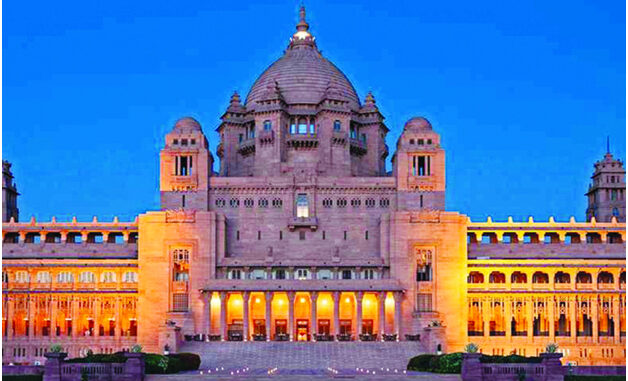
Jodhpur is the second-largest city in Rajasthan and the former capital of the Marwar region. It is popularly called “the Blue City” as it looks completely blue from an aerial view because of its blue walls and houses. Jodhpur is primarily famous for its temples, lakes and snacks, with the magnificent Mehrangarh Fort being the main attraction.
The magic of Jodhpur lies in the streets of the old city itself, which circles the mighty Mehrangarh. Hundreds of shops, guesthouses, eating joints, and vendors make it a bustling chirpy town, especially near the landmark clock tower and Sardar Market. The new and modern Jodhpur lies beyond Mehrangarh. Nearby Jaswant Tada and Umaid Bhawan Palace are also among the top attractions in Jodhpur.
Jodhpur is famous for its delectable food items, especially Pyaaj Kachori, Mirchi Bada and Mawa Kachori. In September, the city hosts the colourful Marwar Festival and Rajasthan International Folk Festival. Some traditional villages are located around Jodhpur, and a tour of these villages (called Bishnoi Village Safari) is one of the popular things to do here. One of the strangest temples in India, where a Royal Enfield motorbike is worshipped, is located nearby and worth visiting. The ancient Thar desert town of Osian is also located here, 65km north of Jodhpur. Seen in the backdrop of the movies, the most popular being The Dark Knight Rises, Jodhpur attracts hundreds of thousands of visitors worldwide. Moreover, it is conveniently located in the centre of Rajasthan, making it the base for visiting nearby places.
Mehrangarh Fort
Mehrangarh, also known as Mehran Fort was built by Rao Jodha in 1459 in Jodhpur, is one of the largest forts in the country. It is situated at the top of a 410 feet elevated hill and guarded by massive walls. One of the most easily recognisable forts in Jodhpur, it has appeared in many Hollywood and Bollywood productions such as The Lion King, The Dark Knight Rises, and the more recent – Thugs of Hindostan. The entrance of the fort, atop a hill, is majestic and has seven gates. These are called Victory Gate, Fateh Gate, Gopal Gate, Bhairon Gate, Dedh Kamgra Gate, Marti Gate and finally Loha Gate. Each of these was built at different times and serves a very specific purpose. While one still has marks of cannon balls being hit on it, the other has spikes that can protect it from elephant and animal attacks. However, Victory Gate was built to commemorate the win of Maharaja Man Singh over Jaipur and Bikaner armies. The fort also has opulent palaces such as the Sheesh Mahal (Glass Palace) and Phool Mahal (Rose Palace).
The intricate carvings on the walls of the fort, the sprawling courtyards, its impressive history, striking palaces, museums and galleries allure tourists from all over the world. The fort also has one of the well-stocked museums of Rajasthan. There are six different galleries in the Mehrangarh Museum: Elephant’s howdahs, Palanquins, Daulat Khana, Armoury, Paintings and the Turban Gallery. National Geological Monument, Nagnecha Mataji Temple, Chamunda Temple and Rao Jodha Desert Rock Park are the tourist attractions in Mehrangarh Fort.
Umaid Bhawan Palace
Voted as the Best Hotel in the world, Umaid Bhawan Palace is also a major tourist attraction in Jodhpur. Apart from being a heritage hotel, it is a museum and the residence of the Royal Family of the present owner, Raja Gaj Singh. Because of its location on the highest point in Jodhpur, the Chittar Hill, it is also referred to as the Chittar Palace. Built-in 1943, the palace was commissioned in 1929, was built in order to provide employment to the drought and grief-stricken farmers of the area and thus took longer to complete. Umaid Bhavan Palace offers amazing hospitality along with heritage walks to unforgettable dining experiences. It was recently in the news for being the site of the Bollywood Superstar Priyanka Chopra and Nick Jonas – a renowned Pop Star from the Band – One Direction.
At present, the 347 – room palace has been divided into three parts. One part is the residence of the royal family, where the tourists are not allowed to enter. The second houses a museum which displays a rich collection of photographs, arms, clocks, stuffed animals and many other possessions of the royal family. The third part of the palace has been converted into a five-star hotel and offers the most exquisite services to its clientele. It is one of the most popular hotels in Jodhpur. Perched atop the mighty Chittar Hill, this palace is often referred to as the Chittar Palace too. To add to the beauty of the palace, there is a beautiful garden outside with lush greenery and different varieties of flowers.
Camel Safari
A trip to the desert would be incomplete without a camel safari across the seemingly endless expanse of the sandy terrain. With Rajasthan being the desert state of India, a trip to this cultural oasis will only feel complete by availing a camel safari. The city of Jodhpur offers multiple packages of varying durations for its visitors. The shortest of these safaris allows one to travel 70 km across the glistening sheets of golden sand of the Thar desert to the ancient town of Osian, steeped in cultural history significant to both Hindus and Jains. If you’re feeling especially adventurous, there are packages offering travellers the opportunity to undertake the incredible journey from the blue city of Jodhpur to the golden city of Jaisalmer, spanning roughly 250 km of the mesmerising desert.
Toorji Ka Jhalra
Constructed in 1740, Toorji Ka Jhalra, commonly called stepwell of Jodhpur, is an intricate design of stepwell, one of the few remaining structures depicting the traditional water management systems of Jodhpur. This architectural wonder was built by the queen-consort of Maharaja Abhaya Singh, a sign of the age-old tradition of the region where royal women were in charge of overseeing the public water works. The design and structure help onlookers comprehend the lifestyle of the earlier generations who had used it in its prime, with the site serving as the local watering hole for its time.
Jaswant Thada
In the royal state of Jodhpur lies Jaswant Thada, a splendid marble cenotaph monument that is also a mausoleum for the kings of Marwar. The memorial was built in the honour and memory of Maharaja Jaswant Singh II by his son Maharaja Sardar Singh in 1899 and is still used by the Marwar Royal Family as cremation grounds. The beautiful edifice is made out of intricately carved marble that is offset vibrantly against the red steps that lead up to the entrance. Jaswant Thada in Jodhpur is considered as an architectural landmark and must be seen by one and all. On the steps leading up to the monument, one can see local musicians and folk dancers entertain the visitors.
The cenotaph also has a beautifully maintained garden which the tourists can explore along with the monument. You can explore the intricate artistry on the carved marbles. The skilfully carved thin sheets of marble are worth appreciating. The entire structure resembles a temple with unmatched beauty. It is also called the Taj Mahal of Marwar and attracts tourists from all over the world.
Mandore Garden
Famous royal cenotaphs, Mandore Garden is located just 9 kilometres away from Jodhpur in Mandore which was once the ruling seat of the Pratihara dynasty. The garden is a part of the more massive Mehrangarh Fort, and also houses the famous Hall of Heroes and the temple of Three Hundred Million Gods. The garden also has a Government Museum, which is full of artefacts and old relics. Source: Holidify





Be the first to comment